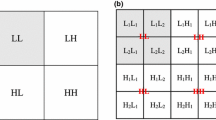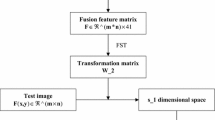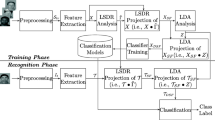Abstract
Many traditional face recognition methods based on Fisher discriminant analysis and locally graph embedding are proposed for dimensional reduction in nonlinear data. However, these methods are not effective by using the face images with non-ideal conditions (such as, variations of expression, pose, illumination and noisy environment). That is to say, face recognition methods are difficult to achieve good performance due to the absence of appropriate and sufficient front training images. Unfortunately, most existing discriminant analysis approaches fail to work especially for single image per person problem because there is only a single training sample per person such that the within-class variation of this person cannot be calculated in such case. In this paper, we present a new face recognition method by using complex number based data augmentation. The proposed method first deals with the information provided by the original face images and obtains the new representations. Then, fuse original face images and the obtained new images into complex numbers by using a simple combination. Then, the samples can be mapped into the new representation space for classification by using the kernel function, and a test face image can be expressed by the linear combination of all the training face images. Finally, the classification predication can be completed via using collaborative representation based classification. The proposed method is abbreviated as ExtendFace. The performance of ExtendFace method is evaluated on ORL and Yale databases. Experimental results show that the ExtendFace method outperforms the other related methods in terms of recognition rates.




Similar content being viewed by others
Explore related subjects
Discover the latest articles, news and stories from top researchers in related subjects.References
Wagner A, Wright J, Ganesh A et al (2012) Toward a practical face recognition system: Robust alignment and illumination by sparse representation[J]. IEEE Trans Pattern Anal Mach Intell 34(2):372–386
Choi JY, De Neve W, Plataniotis KN et al (2011) Collaborative face recognition for improved face annotation in personal photo collections shared on online social networks[J]. IEEE Trans Multimedia 13(1):14–28
Klare BF, Jain AK (2013) Heterogeneous face recognition using kernel prototype similarities[J]. IEEE Trans Pattern Anal Mach Intell 35(6):1410–1422
Ding C, Xu C, Tao D (2015) Multi-task pose-invariant face recognition[J]. IEEE Trans Image Process 24(3):980–993
Yang J, Zhang D, Frangi AF et al (2004) Two-dimensional PCA: a new approach to appearance-based face representation and recognition[J]. IEEE Trans Pattern Anal Mach Intell 26(1):131–137
Mohammed AA, Minhas R, Wu QMJ et al (2011) Human face recognition based on multidimensional PCA and extreme learning machine[J]. Pattern Recognit 44(10–11):2588–2597
Xu Y, Yang JY, Jin Z (2004) A novel method for Fisher discriminant analysis[J]. Pattern Recognit 37(2):381–384
Lu GF, Lin Z, Jin Z (2010) Face recognition using discriminant locality preserving projections based on maximum margin criterion[J]. Pattern Recognit 43(10):3572–3579
Gao JQ, Fan LY, Xu LZ (2013) Median null (sw)-based method for face feature recognition[J]. Appl Math Comput 219(12):6410–6419
Belhumeur PN, Hespanha JP, Kriegman DJ (1997) Eigenfaces vs. Fisherfaces: recognition using class specific linear projection. IEEE Trans Pattern Anal Mach Intell 19(7):711–730
Song FX, Cheng K, Yang JY et al (2004) Maximum scatter difference, large margin linear projection and support vector machines[J]. Acta Automatica Sinica 30(6):890–896
Li X, Fei S, Zhang T (2009) Median MSD-based method for face recognition[J]. Neurocomputing 72(16–18):3930–3934
Li L, Ge H, Gao J (2016) Maximum-minimum-median average MSD-based approach for face recognition[J]. AEU Int J Electron Commun 70(7):920–927
Wan M, Yang G, Gai S et al (2017) Two-dimensional discriminant locality preserving projections (2DDLPP) and its application to feature extraction via fuzzy set[J]. Multimed Tools Appl 76(1):355–371
Wan M, Li M, Yang G et al (2014) Feature extraction using two-dimensional maximum embedding difference[J]. Inf Sci 274:55–69
Wan M, Lai Z, Yang G et al (2017) Local graph embedding based on maximum margin criterion via fuzzy set[J]. Fuzzy Sets Syst 318:120–131
Yang M, Wang X, Zeng G et al (2017) Joint and collaborative representation with local adaptive convolution feature for face recognition with single sample per person[J]. Pattern Recognit 66:117–128
Ding C, Tao D (2018) Trunk-branch ensemble convolutional neural networks for video-based face recognition[J]. IEEE Trans Pattern Anal Mach Intell 40(4):1002–1014
Masi I, Chang FJ, Choi J et al (2019) Learning pose-aware models for pose-invariant face recognition in the wild[J]. IEEE Trans Pattern Anal Mach Intell 41(2):379–393
Gao Q, Zhang L, Zhang D (2008) Face recognition using FLDA with single training image per person[J]. Appl Math Comput 205(2):726–734
Koc M, Barkana A (2011) A new solution to one sample problem in face recognition using FLDA[J]. Appl Math Comput 217(24):10368–10376
Li L, Gao J, Ge H (2016) A new face recognition method via semi-discrete decomposition for one sample problem[J]. Opt Int J Light Electron Opt 127(19):7408–7417
Li L, Ge H, Tong Y et al (2018) Face recognition using gabor-based feature extraction and feature space transformation fusion method for single image per person problem[J]. Neural Process Lett 47(3):1197–1217
Hu J (2017) Discriminative transfer learning with sparsity regularization for single-sample face recognition[J]. Image Vis Comput 60:48–57
Liu F, Tang J, Song Y et al (2016) Local structure based multi-phase collaborative representation for face recognition with single sample per person[J]. Inf Sci 346:198–215
Zhang D, Chen S, Zhou ZH (2005) A new face recognition method based on SVD perturbation for single example image per person[J]. Appl Math Comput 163(2):895–907
Ryu YS, Oh SY (2002) Simple hybrid classifier for face recognition with adaptively generated virtual data[J]. Pattern Recognit Lett 23(7):833–841
Shan GJ (2013) Virtual sample generating for face recognition from a single training sample per person[J]. Sci Technol Eng 13(14):3908–3911
Xu Y, Li X, Yang J et al (2014) Integrating conventional and inverse representation for face recognition[J]. IEEE Trans Cybern 44(10):1738–1746
Xu Y, Fang X, Li X et al (2014) Data uncertainty in face recognition[J]. IEEE Trans Cybern 44(10):1950–1961
Liu Z, Song X, Tang Z (2015) Fusing hierarchical multi-scale local binary patterns and virtual mirror samples to perform face recognition[J]. Neural Comput Appl 26(8):2013–2026
Xu Y, Zhang Z, Lu G et al (2016) Approximately symmetrical face images for image preprocessing in face recognition and sparse representation based classification[J]. Pattern Recognit 54:68–82
Zhang Z, Xu Y, Yang J et al (2015) A survey of sparse representation: algorithms and applications[J]. IEEE Access 3:490–530
Jia X, Yang H, Ma S et al (2014) Quaternion higher-order spectra and their invariants for color image recognition[J]. Opt Lasers Eng 57:28–39
Sun Z, Shang L (2016) A local spectral feature based face recognition approach for the one-sample-per person problem[J]. Neurocomputing 188:160–166
Yan X (2016) Single sample face recognition based on sample augments and MSD fusion. In: IEEE Information technology, networking, electronic and automation control conference. IEEE, pp 352–355
Lu J, Tan YP, Wang G (2013) Discriminative multimanifold analysis for face recognition from a single training sample per person[J]. IEEE Trans Pattern Anal Mach Intell 35(1):39–51
ORL Face Database (1992–1994). AT&T Laboratories, Cambridge. http://www.cl.cam.ac.uk/research/dtg/attarchive/facedatabase.html
Belhumeur PN, Hespanha JP, Kriegman DJ (1997) Eigenfaces versus fisherfaces: recognition using class specific linear projection[J]. IEEE Trans Pattern Anal Mach Intell 19(7):711–720
Acknowledgements
This work is partially supported by the Doctoral Research Foundation of Jining Medical University under Grant No.2018JYQD03, and a Project of Shandong Province Higher Educational Science and Technology Program under Grant No.J18KA217, Graduate Innovation Foundation of Jiangsu Province under Grant No.KYLX16_0781, the 111 Project under Grant No.B12018, and PAPD of Jiangsu Higher Education Institutions, China, and Xinjiang Agricultural University’s Science and Technology Plan for Vitalizing Rural Areas and Overcoming Poverty under Grant No.XCZX2019014.
Author information
Authors and Affiliations
Corresponding author
Additional information
Publisher's Note
Springer Nature remains neutral with regard to jurisdictional claims in published maps and institutional affiliations.
Rights and permissions
About this article
Cite this article
Gao, J., Li, L. & Guo, B. A New ExtendFace Representation Method for Face Recognition. Neural Process Lett 51, 473–486 (2020). https://doi.org/10.1007/s11063-019-10100-1
Published:
Issue Date:
DOI: https://doi.org/10.1007/s11063-019-10100-1




